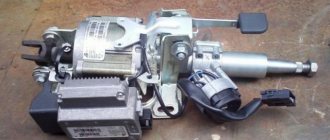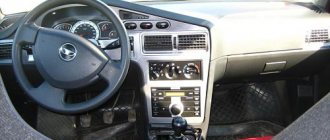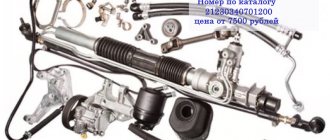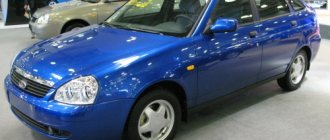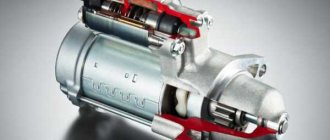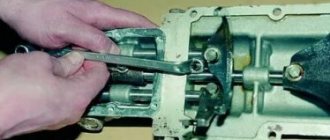In modern cars, including the Lada Priora, you can turn the steering wheel with at least two fingers, even while the car is parked; before, if anyone doesn’t know, this didn’t happen. Thanks to modern technology, electric power steering has appeared. However, as many people know, Priora, like any domestic car, often presents surprises, so ESD malfunctions of various types occur. In this material, we propose to understand why such an extremely important device as electric power steering does not work and what are the ways to eliminate the troubles associated with this.
The role of the electric power steering in the steering of the VAZ 2170 Priora
It's no secret that the electric control method plays an important role in ensuring safety while driving. EUR or power steering of Priora performs the option of reducing the level of load on the steering wheel while turning it. The key advantage of using such an EUR device on the Priora is comfort when moving as a result of improved feedback between the steering wheel and wheels.
The electric amplifier is a more modern and improved unit, which is not only easier to use, but also does not require the introduction of additional highways to ensure operation. In addition, this device does not take power from the power unit. The main advantage of the EUR is that it does not require frequent maintenance and fluid monitoring, unlike power steering.
But it should be noted that such a system has several disadvantages, one of them is rather weak feedback between the road surface and the control system. As a result, it may become difficult to drive in snow. Unlike Prior, foreign cars are equipped with additional mechanisms and units for blocking and stabilization, so the method of controlling the electric power steering in the domestic version is less reliable. In addition, in practice, a faulty electric booster with poor traction is a fairly common occurrence.
Problems in the operation of the hydraulic booster
All breakdowns of the Priora power steering, as well as the causes and methods of eliminating them, are listed in the table:
| Malfunction | Cause | Remedy |
| When turning the steering wheel, you feel a kickback (shocks in the opposite direction) | Worn or loose pump drive belt | Replacing or adjusting belt tension |
| It takes a lot of effort to turn the steering wheel. | The pump belt is worn or loose. Low fluid level in the reservoir. The fluid reservoir filter is clogged. Low pump pressure or air lock in the system. Insufficient engine idle speed. | Adjust or replace the drive belt. Add liquid to the reservoir. Replace or clean the filter. Replace the pump. Remove the air lock. Adjust idle speed. |
| More effort is required to rotate the steering wheel in the middle position | Pump or steering mechanism faulty | Check, repair or replace the pump. Find and fix the steering mechanism problem |
| More effort is required to turn the steering wheel to one side | The pump has failed | Pump repair or replacement |
| Steering is unclear | There is not enough fluid in the reservoir or it is leaking. Air in the power steering system. Resource development. | Add fluid and fix leaks if any. Remove the air lock. Check steering components and replace if necessary. Replace tires. |
| It takes a lot of physical effort to quickly turn the steering wheel | The belt tension has weakened. Air in the system. The pump is faulty. Failure of parts of the steering mechanism. Floating idle speed. | Pull the belt. Remove the air lock. Replace the pump if it cannot be repaired. Check and eliminate faulty parts of the steering mechanism. Adjust idle speed. |
| Noise during power steering operation | There is not enough liquid in the tank. The liquid is discharged through the safety valve (a whistle is heard when the steering wheel is turned to the extreme position). | Add fluid and fix the leak. Remove the air lock. Check the pump pressure, repair or replace the part. |
| Steering wheel vibration | Airlock. The wheels are out of balance or the tires are damaged. | Remove air. Balance wheels or replace tires |
In practical terms, power steering is more often replaced with a new one or with a known good one. The original device costs a lot, so they choose analogues. Models from Chinese manufacturers have proven themselves to be an inexpensive option of good quality.
Disassembling the steering column
Conversion of Torque units. Torque units, torque units, torque units, torque units. Table
For this procedure you need to prepare:
- wrench 8 (socket);
- at 13 (end);
- Phillips screwdriver.
Before starting work, it is important to disconnect the battery. To do this, it is enough to remove the wire from the negative terminal
- remove the steering wheel;
- the plastic shields are removed from the column (they are held on by two screws and clamps each);
- dismantle the lower part of the lining by unscrewing 4 bolts;
- disconnect the wires from the lock and turn signal switch, etc.;
- using a 8 key, partially loosen the clamp holding the above-mentioned devices and remove them completely;
- pull out the connector terminals of the EUR controller;
- remove the plastic cover.
When driving a car, the steering mechanism and braking system play a huge role in safety.
Therefore, it is important to monitor the proper operation of these elements
Increasingly, a power amplifier is installed on the steering mechanism of a passenger car. Its task is to reduce a person’s effort on the steering wheel during maneuvers. At the moment, the car can be equipped with one of two types of power steering: hydraulic power steering (power steering) and electric power steering (electric power steering).
Common faults and solutions
Where is the speedometer sensor located on the VAZ 2110? Where is the speedometer sensor located?
Many prior drivers encounter device breakdowns, in particular, we are talking about a malfunction of the control unit. If the system control unit does not work correctly or is faulty, a corresponding error will appear on the on-board computer display. Having deciphered it, you can understand that the computer reports a failure of the EUR connection, which in most cases indicates the presence of problems in soldering. In particular, we are talking about the connection point between the amplifier board and the controller.
This malfunction can be solved either by replacing the system at the dealer, if the car is under warranty, or by repair. If you do not have experience in chip tuning or working with electronic devices, then solving such a malfunction should be entrusted to professionals. Of course, in order to accurately make a “diagnosis”, you will need to conduct computer diagnostics.
It often happens that the speed sensor malfunctions, which again contributes to the appearance of an error on the on-board computer. This type of malfunction can be solved by reprogramming the device or replacing the wires in the places where the regulator connects to the controller. If the regulator itself is not working, then it will have to be replaced (the author of the video is Alexey a-skorp).
Too low voltage level in the car's on-board network is also a common problem
In this case, it is necessary first of all to pay attention to diagnosing the generator device or wiring. Use a tester to check
In any case, if problems are detected in the operation of the system, it is necessary to repair the steering rack yourself. Operating a car with a non-functional ESD is not allowed until the problem is completely eliminated.
How to determine mechanical damage to the EUR and steering mechanisms?
Mechanical diagnostics are carried out if it is not normal, but the on-board computer does not generate errors. To check for mechanical damage, you need to turn the steering wheel left and right as much as possible, while the engine must be running. It should be noted that when turning the steering wheel, the vehicle must remain in one place.
If you notice that when turning the steering wheel you need to apply more force than usual, this may indicate a failure of parts or components of the amplifier. But this may also indicate a breakdown of other elements of the steering system (a video about diagnosing power steering using a paper clip is presented below, the author of the video is Gosha Vakhromeev).
To accurately identify what caused the problem, you will need to conduct a more thorough diagnosis. To do this, the vehicle first needs to be driven onto a lift and raised, while carefully checking all the elements of the chassis for operability. Racks, tie rods, etc. must be checked. This procedure can be carried out without any problems at any service station or on your own, but only if you have a lift and certain diagnostic skills. There is a possibility that repair of the EUR is not required, since it itself is operational, but repair of other elements is required.
To prevent the occurrence of malfunctions associated with the electric amplifier, it is necessary to clean the system, as well as contact nodes, from time to time. To carry out service yourself, you will need to remove your EUR, completely disassemble it, clean it and put it back. We will tell you more about this below.
Fuse box location
If you suspect that a fuse has blown and you want to check it, then the question arises: where is the Priora electric power steering fuse located? The control mounting block is located to the left of the steering wheel. Its opening scheme is simple. All you need to do is turn the three latches 90˚ and remove the cover, as shown in the photo, and you get to the brain stuffing of the car.
Here you can check and replace the failed fuse, then close the lid by pressing it tightly and snapping the three latches back 90˚ in the opposite direction.
You can carry out diagnostics and minor repairs to the Priora's electric power steering with your own hands. To do this, it is enough to determine what caused the failure and fix the problem, following our advice. It is better to entrust a complete replacement of the electric amplifier to professionals.
Replacing the EUR
Where is the fan switch on VAZ 2114 photo?
So, you need to replace the electric booster on the Priora or simply check the condition of its contacts. In any case, repair involves complete removal of the unit. Prepare the necessary tools:
- Chisel and hammer.
- Deep head for 8 and 13.
- Extension and ratchet, alternatively you can use a wrench.
It’s quite easy to remove the amplifier itself with your own hands, but in order to get to its mounts and the control unit, you will need to remove many parts of the dashboard: the steering wheel along with the airbag, the casing and the ignition switch. Once these components are removed, repairs to the amplifier can begin.
Step-by-step instruction
- We take the “eighth” head, put on the ratchet and remove the contact group, as shown in the photo below;
Now you can study the contacts in detail and, if necessary, make repairs. If you know that the main components (control unit, motor) have failed, then you need to replace them. Installation of a new device occurs in the reverse order. The DIY repair is complete.
There are two types of power steering: electric power steering and hydraulic power steering. Priora was composed of both. The price is higher for EUR, but sometimes it doesn’t work. The electric power steering of the Priora car has an analogue of the AENK-K, but it is 2 times more expensive than the standard power steering of the Lada Priora. With Eur, the steering wheel of a Priora car becomes much lighter. With gur you feel the road. Compared to the Eur, the Priora has more spare parts, is attached to the pentosin liquid, it needs to be monitored, topped up - so that starvation does not occur! The price for replacement also differs depending on the system, the EUR is easier to replace and can be called with a diagnostic connector, so this is the electric motor. Electric power steering (EPS) for Priora comes in two types: geared and gearless - and the first is an outdated technology that was installed on the first Priora - read about it in the article below.
The presence of electric power steering on the Priora has become an indispensable requirement for every car enthusiast. This is justified: once upon a time, the owners of domestic “Zhiguli”, from the first years behind the wheel, learned to turn the steering wheel with both hands with maximum effort. On modern cars, you can turn the steering wheel even on the spot in a snowdrift with one hand, therefore, when choosing a Lada Priora in the cabin, electric power steering was the first mandatory item in the package for many. Later they began to install steering wheel and power steering in all configurations.
Electric power steering is not installed on the Priora in all trim levels - the simplest one has power steering. Knowing the power steering device and being able to “bring it to life” is the direct responsibility of the Priora driver, who loves his car.
How to check and replace a fuse or relay
Before replacing a faulty fuse, it is necessary to perform diagnostics according to the following principle:
- Verify that the consumer is actually not running.
- Find the appropriate fuse in the table.
- Take it out and check the condition of the fusible part.
- If it is impossible to verify the integrity of the thread, test it with a multimeter.
- The presence of a break when testing two contacts indicates a burnt-out insert.
In this case, you should re-install a new fuse and try to use the consumer.
If the insert burns out again, re-installation of a new insert is prohibited! It is necessary to check the equipment circuit for a short circuit.
The relay is easier to check - the absence of clicks from its side may indicate problems in the circuit or a malfunction of the relay itself.
It is enough to pull it out and install in its place any other adjacent one with a similar rating and contacts. If installing a new relay fixes the problem, then that was the problem.
Chip errors
When a situation is observed that the wheels turn on their own, the reason is the electronic filling of the Priora electric power steering control unit.
As mentioned above, quality was sacrificed for the sake of economy. Now the situation with this seems to have improved and everything has been finalized, but if suddenly you feel that the steering wheel is starting to move by itself, go for repairs. If, along with the electric power steering, the speedometer also fails, then you need to look at the speed sensor. It was either simply dirty or broken. The same applies to the torque sensor installed on the amplifier. Clean them well and check their functionality.
Don’t forget to reset errors on the on-board computer; this can be done in several ways.
- Remove the terminal from the battery, wait a few seconds and put it back, the error should go away.
- Using a computer, the corresponding software can be found on the Internet.
The decoding is as follows:
- 1 long 1 short System OK;
- 1 long 2 short No engine speed signal;
- 1 long 3 short Torque sensor faulty;
- 1 long 4 short EMUR motor malfunction;
- 1 long 5 short Faulty steering shaft position sensor;
- 1 long 6 short Malfunction of the EMUR engine rotor position sensor;
- 1 long 7 short Malfunction of the car's electrical system (below 10V or more than 18V);
- 1 long 8 short Malfunction of the EMUR control unit;
- 1 long 9 short Vehicle speed sensor malfunction;
Advantages and disadvantages over power steering
Power steering (power steering) was once the ultimate dream for many, but you had to tinker with it - which only cost the constant addition of working fluid to the reservoir, plus a thrifty attitude towards the mechanism.
Benefits that the owner of a Priora with EUR receives:
More reliable mechanism. It's simple - there is nothing that often breaks (pulleys, hoses) or runs out (liquid). In addition, diagnostic data on faults can be obtained from the ECU. Installation, according to the manufacturer, will take no more than 1.5 hours - with wires everything will be much easier than with connecting hoses. In addition, you don't have to climb into the engine compartment. Passive impact safety Adjustability. Initially, after installation, the force will increase with increasing vehicle speed. This can be changed by reprogramming the data in the ECU - for example, reducing the force from the mechanism with increasing speed. Energy saving. The electric motor inside does not work constantly - it starts only when the driver starts to turn the steering wheel.
It would be wrong to remain silent about the shortcomings:
You don’t “feel” the road - power steering makes the car more sensitive, an experienced driver appreciates this. The EMUR mechanism (electromechanical power steering) is more expensive than power steering. Basic faults
The best plan is to identify the malfunction of the device before starting to move, otherwise a surprise while driving can lead to surprises. It turns out that while driving a person will continue to apply little effort to turning the steering wheel, which is why the car can go straight during the intended turn.
When turning on the ignition, always wait until all the sensor lights come on. The EUR sensor in the form of a steering wheel will also light up. Within two seconds, the electronic control unit diagnoses the entire system; if after this time the sensor does not burn out, the ECU has found a fault.
Not every malfunction of the ECU is reflected on the dashboard:
Shocks in the steering wheel; When the engine is off and when the engine is on, the hand effort is almost the same. As mentioned earlier, the ECU controls everything. Of course, you can find out about any breakdown through the diagnostic connector, to which you can connect yourself. It may produce the following error codes that relate to the EUR:
If the electric power steering on a Priora does not work, and it is not even possible to connect to the diagnostic connector, you can try the old “old-fashioned” method:
Insert the key into the ignition lock. In the eight-pin connector of the control unit, close contacts 6 and 7 (the first one is near the latch, upper right); Turn on the ignition, but do not turn on the engine. In this case, you need to look at the dashboard - at the place where the EMUR icon lights up.
Why is it needed and its device
ESD is an electrical mechanism that reduces the control force with which the driver turns the steering wheel. It turns out that this cunning device takes on most of the effort, leaving the driver responsible for the safety of the maneuver. The design of the EUR is as follows:
- Electronic control unit and electric motor;
Controller and peripherals
- Steering wheel;
- Output/input shaft;
- Studs, nuts, bolts, etc.;
- Bracket;
- Steering rack;
- Connections;
- Steering wheel tilt adjustment lever.
It works like an ordinary electronic mechanism - for example, like a prosthesis: receiving data from sensors about the resistance of the road surface, vehicle speed, crankshaft speed, the force that the driver applies to turning the steering wheel, the “brain”, the electronic control unit, delivers the electric motor to sufficient power to so that the car can be controlled with one finger.
The steering column becomes almost weightless, and does not even give off the vibration familiar to many from prolonged holding in the extreme position.
Possible malfunctions, signs and causes
In what cases is the steering rack, power steering and power steering disassembled and repaired, what is the diagram, what functions does the torque sensor perform?
First, let's look at the main malfunctions of the system, why it does not work and how to fix them:
- Incorrect operation or breakdown of the control unit is one of the most difficult reasons for the inoperability of the EUR and power steering in the Lada Priora. If such a problem occurs, a corresponding error message will appear on the on-board computer screen. If you decipher it, you will find out that the computer has detected that the control module is inoperable. Such problems are usually associated with soldering problems. Most likely, the reason is a lack of connection or poor contact between the amplifier circuit and the controller. Such a malfunction can be solved by repair, that is, re-soldering, or replacement if we are talking about a car under warranty. You can find out more accurately about problems by conducting computer diagnostics.
- Failure of the speed controller. If the speed sensor breaks down, the electric booster turns off spontaneously or does not work at all, and an error message about inoperability will appear on the computer display. In this case, you can try to reconfigure the device or change damaged sections of the electrical circuit at the junction of the sensor and the control unit. Sometimes the reason lies in poor contact of the sensor with the on-board network, then the connector will simply need to be corrected. If the malfunction is associated with a non-functioning sensor, the device must be removed and replaced.
- The steering wheel turns with great difficulty. First of all, the reason should be sought in the lack of lubrication. If there is little oil in the system, the steering wheel will be difficult to turn, and uncharacteristic noise or creaking may be heard during rotation. Check the lubricant level and add oil if necessary.
- Prolonged operation of the electric booster without lubrication can lead to pump failure. The malfunction is accompanied by sounds uncharacteristic of the operation of the EUR, as well as difficult rotation of the steering wheel. If the pump can be repaired, then you can consider yourself lucky, but if it can’t, then the device will have to be replaced.
- Malfunctions in the operation of the electric amplifier can also be caused by reduced voltage in the machine's electrical network. If the voltage in the on-board network really jumps, then you should initially check the generator and the electrical circuit for its connection. For diagnostics, it is recommended to use a multimeter or voltmeter (video author - Alexander Loginov).
Priora steering rack malfunctions
Problems with the functioning of the steering rack can be different. To identify them, it is not necessary to have a wealth of special knowledge; it is enough to periodically inspect the mechanism.
Large steering play
If you turn off the engine and actively turn the steering wheel, there should be no extraneous sounds. When not only suspicious noises appear, but also play is observed, the cause of the problem may be a weakened spool stop or insufficient elasticity of the torsion bar. The steering wheel may play due to severe wear of the silent blocks on which the steering rack is fixed. The same problem occurs when the angle of contact between the teeth and the screw is incorrect, or the curvature of the crankcase or shaft is caused by damage or the stroke of a screw-type bearing. To determine the malfunction, you will need to diagnose the rack bushing, steering rod joints and teeth.
The appearance of knocking and heaviness when turning the steering wheel
The steering wheel becomes heavy due to a soured cardan, but most often it is the knocking that occurs. There are a number of characteristic reasons for this phenomenon:
- noise occurs during the movement of the vertical bearing shaft;
- excessive wear of joints and crankcase;
- exhaustion of the life of a screw bearing, bushing or teeth;
- crooked shaft or crankcase, as a result the screw contacts the teeth with an offset angle;
- wear of silent blocks;
- loose rack fastening;
- steering wheel play.
In any case, you will need to carry out diagnostics, and if malfunctions are identified, you will need to dismantle and repair the Priora steering rack with replacement of worn elements.
Worn steering shaft center tooth
Wear of the mechanism with teeth occurs quite often. The main purpose of the steering shaft is to convert rotational motion into translational motion. Most cars are characterized by the exhaustion of the resource of the central teeth. The reason is simple: movement in city traffic is determined by driving in a straight line with slight deviations of the trajectory to the left or right.
To determine the malfunction, you need to swing the steering wheel to the sides from the middle position. If knocking noises are heard, it is better to carry out further diagnostics at a service station. If the central tooth is worn excessively, the entire shaft must be replaced.
Diagnostics
First of all, it should be noted that a breakdown that occurs with the EUR is determined by the indication on the instrument panel.
It has a light bulb with a schematic representation of a steering wheel and an exclamation mark. Normally, after starting the engine, it lights up for a couple of seconds and then, after self-diagnosis performed by the ECU, goes out when no faults are detected. But when a problem is detected, the indication does not turn off.
Do not forget that the electric amplifier controller communicates peripherally with the vehicle's ECU. Therefore, it is better to identify this kind of breakdown at a service station using a computer.
However, individual devices are currently available for sale to test the functionality of certain electronic components. They are easy to use and are quite inexpensive - up to 1.3 thousand rubles.
Thus, an individual scanner allows you to find out what happened to the car. It should be connected to the ECU - the latter will generate error codes. All related to ESD malfunctions begin with “C”. In particular, C1013 signals that the voltage in the on-board system is too low - this means that it is not enough for the amplifier to operate normally.
According to experts, the most common problems are the following:
- breakage, burning or short circuit of the wires supplying the EUR (they are red and black, have a larger cross-section than the others, and are also included in a separate connector);
- fuse blown;
- low voltage.
In the latter case, you need to check both the battery and the generator.
Malfunctions and their symptoms
Undoubtedly, the electric booster is a more reliable unit than a device running on hydraulics, but malfunctions also appear in the power steering. If they are detected, repairs must be carried out immediately, since the safety of the driver, his companions and other road users depends on the operation of the amplifier.
Complete failure of the EUR
As practice shows, this unit does not have many faults; breakdowns occur in the same parts. The first thing worth considering is the complete failure of the ESD. When you turn off the amplifier, you need to check the on-board computer screen; most likely, you will see a code there indicating a malfunction in the unit. But sometimes it is possible to determine when an amplifier is turned off only in practice.
We perform the following actions:
- Turn off the engine and turn the steering wheel in different directions several times;
- We repeat these steps, but with the engine running;
- Has the steering effort changed? This means the node has completely shut down.
Sometimes the amplifier and speedometer stop working at the same time. The cause of this defect is a speed sensor that has failed. Taking a look at the electrical diagram, you will understand that these three elements are connected. The torque sensor supplies data to the control unit, it compares it with speed and determines the force. If the cause is the speed sensor, then the repair consists of checking the wiring that leads to this element. It is also worth checking the wires connecting the sensor to the speedometer and power steering. If there are no breaks in the switching, then the sensor should be changed.
Low voltage in the car network can also lead to the ESD turning off. Faults should be looked for in the wiring insulation. If it is damaged, short circuits will appear in the network. Also, violations in insulation lead to malfunction of the generator. To troubleshoot the problem, check the wiring and generator. The torque sensor contains many contacts, which, if heavily soiled, help turn off the power steering. In this case, repair means disassembling the unit and cleaning the contacts of the torque sensor.
Unpredictable steering behavior
The driver is driving on a flat road, the position of the steering wheel does not change, and suddenly the car turns to the side. Such unpredictable behavior of the power steering requires urgent diagnosis, since at the most inopportune moment the electric power steering of the Lada Priora can send the car to the side of the road or into the oncoming lane. In such a situation, you should stop driving and turn off the amplifier. To do this, we need to remove the fuse, which is responsible for supplying voltage to the amplifier.
To remove this fuse, you need to do the following:
- The mounting block cover is located at the driver’s left foot;
- We turn the clamps and unclip the fasteners;
- You will find the block where the required fuse is located near the expansion tank;
- Feel free to take out fuse F5 (50 A) - it is responsible for providing the power supply circuit to the power steering unit.
The reason for this behavior is a malfunction in the electric amplifier device. This could be a torque sensor, control unit, clogged contacts or mechanical damage. It is recommended that diagnostics be carried out by professionals, since in a garage you will not be able to check the control unit; replacement can be done with your own hands.
We use the “folk” method of checking the malfunction
In the case when the light on the LADA Priora does not light up, and there are faults with the EUR, and perhaps it is necessary to carry out control after the repair work has been carried out, then you can do this: turn the car steering wheel, without the ignition on, remember the force. Next, start the engine and repeat the action. If there are no changes between the two actions, then it is obvious that the ESD is not in order, you need a more detailed diagnosis of the car, and then choose the most suitable methods for troubleshooting, and this, let us tell you, is not at all problematic.
How to remove the EUR on a Priora with your own hands
In fact, the electric power steering can be removed without any problems, you just have to remove quite a lot of parts first. Namely, you will need to do the following:
After that, using an 8 mm socket and a ratchet, unscrew and remove the contact group.
We remove it from the shaft completely so that it does not interfere.
Now you need to disconnect all the power wires from the power steering control unit, which are clearly shown in the photo below.
Each of the plugs has its own lock, so be sure to first look at the design of the lock so as not to damage it when removing it. When you have dealt with the wires, you need to unscrew the coupling bolt at the fastening of the driveshaft with the steering rack.
Using a chisel and a hammer, we slightly expand the coupling “collar” of the cardan shaft. Then you can begin to unscrew the nuts securing the EUR to the body. Two nuts are located at the front.
And two from the bottom.
Of course, when unscrewing the last fastening nuts, it is necessary to hold the EUR so that it does not fall. Next, we pull it off the steering rack shaft and remove it completely. If necessary, we replace it with a new one. This mechanism is installed in the reverse order and we connect all the necessary wires to their places.
Device
The main components of the EUR are:
- electrical part;
- mechanical;
- controller and peripherals.
The first category includes, in particular, the electric motor.
The mechanical part consists of:
- steering wheel parts;
- connections;
- input and output shafts;
- bracket;
- tilt adjustment lever;
- studs, bolts, nuts, etc.
This also includes the steering rack.
As practice has shown, most often it is electronic devices that fail, that is, ECUs, sensors and the distribution terminals connecting them.
Removing and installing EUR at home
In order to remove the device from the car, you will need to prepare in advance everything that may be useful to you in the process. In particular, we are talking about flat-head and Phillips-head screwdrivers, as well as a set of socket wrenches.
So, how does the procedure for removing and installing the electric amplifier take place:
- First of all, you need to turn off the power to the on-board network; to do this, disconnect the negative terminal from the battery. Then dismantle the steering wheel by first removing the plastic cover under it and on the control panel. The steering wheel is dismantled in accordance with the service book for the car.
- Using a Phillips screwdriver, you need to unscrew the four bolts that secure the decorative trim on the steering panel.
- Having done this, you will be able to see the wiring pads - they need to be disconnected from the steering column switch, and the slip ring is also disconnected.
- Using a size 8 wrench, you need to unscrew the screw that secures the wire blocks that run from the ignition switch.
- Next, you need to press on the plastic fixing elements and disconnect the pads with wires at the top and bottom of the column itself.
- In the place where the electric power steering wheel is attached to the column itself, you will need to dismantle the so-called plastic curtain; to do this, disconnect the clamps.
- Using a socket wrench, you need to slightly loosen the nuts that secure the assembly to the bottom of the column.
After completing these steps, the amplifier itself is removed - it is dismantled along with the intermediate shaft. But in order to make it more convenient for you to clean the assembly and then perform the installation in reverse order, it is advisable to disconnect these components from each other in advance. To do this, use a 13mm wrench to unscrew the screw securing the universal joints to the shaft itself. Then you will need to unscrew the two fixing nuts at the ends, after which the steering column itself can be removed.
Then you will need to remove the screw and remove the cardan from the splined pulley of the unit. To make the reinstallation procedure more convenient after removal, it is advisable to make sure that all marks match. We are talking about marks on the protective cover, pulley, and also the starter cover
Cleaning the contact group mechanism and other elements of the system must be done carefully so that all components remain intact and undamaged. If you seek help from specialists in this matter, the cleaning procedure will cost you on average about 30-50 dollars, depending on the region
Today, every Priora is equipped with electric power steering, this also applies to the basic configuration. Although initially the device was intended as an additional comfort function. Owners of this model know that the unit often jams and breaks, but if necessary, repairs can be done with your own hands. More on this later in the article.
Thanks to the operation of the electric power steering, the load and force on the steering wheel are reduced when turning. The unit greatly facilitates vehicle control and does not allow dangerous maneuvers to be made at high speed. The node includes the following elements:
- Electric motor.
- Column.
- Steering wheel.
- Torque sensor.
- Electronic control unit.
- Steering mechanism.
When you turn the steering wheel, the EUR is activated. The torque is provided by the electric motor present in the design of the electric amplifier. The torque sensor measures the indicator and sends it to the electronic unit. Depending on the angle of rotation, the ECU calculates how much power needs to be given to the engine. The switch, which is located under the steering wheel, has a device that determines the angle of rotation. The rotation and torque sensors transmit information to the electronic unit, which determines whether the electric motor is operating at the required speed.
On previous generations of VAZ, a hydraulic booster was installed, which gave virtually the same force in all rotation ranges. As for the electric booster, the degree of effort here depends on a lot of factors: the speed of rotation of the steering wheel and its angle, the speed of the power plant, and driving speed.
Description of relays and fuses in the engine compartment
Fuse links located near the generator have the highest rating. Their purpose is to protect and power the main circuits of the engine.
Fuse table under the hood:
| Number | Denomination | Purpose |
| F1 | 30 | Power supply to the engine ECU power circuits. |
| F2 | 60 | Power supply for the cooling fan, heated rear window, electrical package ECU and ignition relay. |
| F3 | 60 | Fan control circuit, power supply for instrument panel, brake light, cigarette lighter, horn and interior lighting. |
| F4 | 60 | Generator power circuit |
| F5 | 50 | EUR |
| F6 | 60 | Generator power circuit |
Standard electric amplifier article number and price
On the market you can find geared (outdated) and gearless EPS (electromechanical power steering) for Priora. It is worth concentrating on the second option, there are reasons for this:
Fast request processing: the “intermediary” - the gearbox - disappears - the ECU copes faster with the driver’s commands; More durable. The gear transmission of the gearbox can break at an inconvenient moment, but in a gearless electric power steering system the moment is transmitted directly to the steering rack. The noise level is reduced. The article number of the gearless EUR for the VAZ 2170 Priora is 2172-3450008-02. The price ranges from 20,000 to 25,000 rubles. The cost of a geared EUR is two thousand lower, but is it worth it - to skimp, pay less money, and then deal with frequent breakdowns?
Prevention measures
To maximize the service life of the Priora steering rack, follow simple operating rules:
- bumps, potholes and speed bumps must be driven over at low speed and carefully;
- periodically inspect the condition of the anthers and seals;
- The oil in the power steering should be warmed up before driving (short turns by steering wheel);
- It is not recommended to frequently hold the steering wheel in the extreme right or left position.
By following these simple rules, you can avoid expensive repairs or replacement of the unit.
Purpose of the unit
Due to the operation of the ESD, the load and force on the steering wheel are reduced when making a turn. The unit greatly facilitates driving, and at high speed it does not allow dangerous maneuvers.
The unit includes the following components:
- Steering wheel;
- Column;
- Shaft;
- Electric motor;
- Steering mechanism;
- Electronic control unit (ECU);
- Torque sensor.
When turning, the electric power steering is activated. The torque is provided by an electric motor, which is present in the EUR design. The torque sensor measures the indicator and sends it to the ECU. Depending on the angle of rotation, the block calculates how much power needs to be given to the motor. The switch located under the steering wheel contains a device that determines the angle of rotation. The torque and rotation sensors transmit data to the ECU, which “determines” whether the electric motor is running at the desired speed.
On previous generations of VAZ cars, a hydraulic booster was installed; it gave almost the same force in all rotation ranges. As for the electric power steering, the degree of force depends on many factors - the speed of rotation of the steering wheel and its angle, the speed of the power plant, the speed of movement.
How does the electric power steering wheel work?
The automotive device we are considering in this material for the Lada Priora consists of the following components:
- ECU with corresponding peripherals. This block contains connectors with special sensors.
- Electrical part. This part is the motor of the device. Mostly this component is the most vulnerable.
- Mechanical component. This includes steering components, fasteners and connecting parts. This component consists of: an adjustment lever necessary to change the angle of the steering wheel, as well as the output and input shafts, here you can also add springs, nuts, and do not miss the studs and bolts.

